Pecharsky V.K., Zavalij P.Y. Fundamentals of Powder Diffraction and Structural Characterization of Materials
Подождите немного. Документ загружается.


402 Chapter
5
example, when the accuracy is nearly ideal, e.g. when the calculated rather
than the experimental Bragg angles are used to determine d*hkl, indexing is
usually straightforward and consistent even for large and low symmetry unit
cells. However, the presence of systematic errors combined with multiple
and sometimes severe overlaps of Bragg reflections (the latter are often
observed in complex crystal structures characterized by low symmetry, high
unit cell
volunle lattices) reduces the accuracy of peak positions and
therefore, decreases the chances of successful indexing from first principles.'
As established earlier (see section 2.8, Chapter 2), the interplanar
distances, d, are related to both the unit cell dimensions and Miller indices of
the families of crystallographic planes by means of a well defined function,
which in general form can be written as follows:
Peak positions,
€Ihkl, are measurable from a powder diffraction
experiment, for example using any of the approaches discussed in Chapter
4.
Thus, the observed d-spacing for any given combination
(hkl)
is established
by means of the Braggs' equation, in which
3L
is the wavelength used to
collect the data and
n
=
1,
i.e. only the first order reflections are included
into the consideration:
d;;;
=
h
2
sin
8",;
By combining Eqs. 5.2 and 5.3, the observed positions of Bragg peaks
may be used to calculate the corresponding unit cell dimensions, but first,
the triplets of integer indices, h,
k
and
I,
should be assigned to all observed
diffraction maxima or in other words, all observed Bragg peaks should be
indexed in agreement with Eqs. 5.1 to
5.3.
The algorithm of the indexing
process in powder diffraction is usually dependent on whether or not the
shape and dimensions of the unit cell are known at least approximately.
5.3
Known versus unknown unit cell dimensions
Indexing of powder diffraction data when unit cell dimensions are known
with certain accuracy includes:
Similar to structure solution from first principles, the
ab
initio
indexing implies that no
prior knowledge about symmetry and approximate unit cell dimensions of the crystal
lattice exists. Indexing from first principles, therefore, usually means that Miller indices
are assigned based strictly on the relationships between the observed Bragg angles.
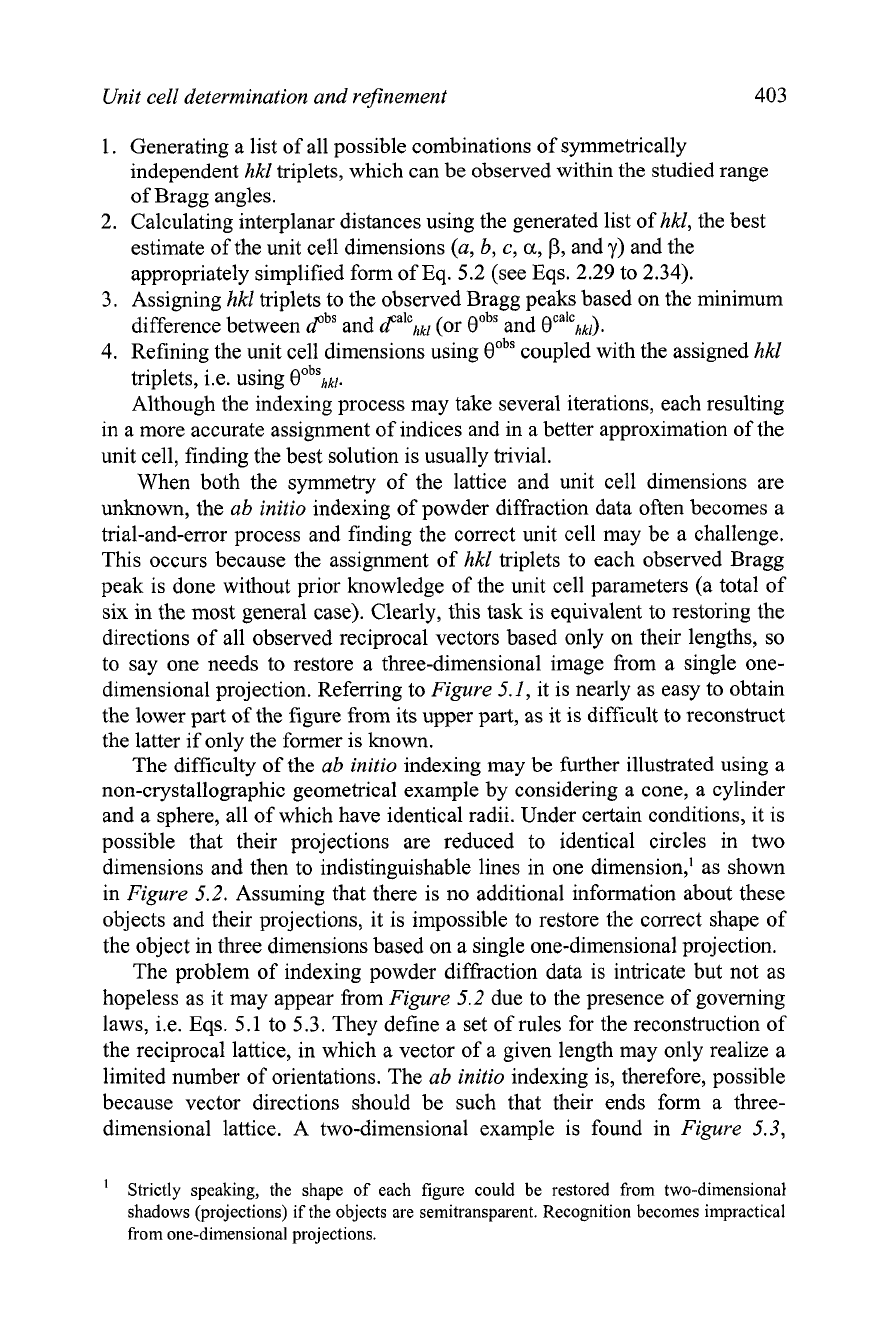
Unit cell determination and refinement
403
1.
Generating a list of all possible combinations of symmetrically
independent
hkl
triplets, which can be observed within the studied range
of Bragg angles.
2.
Calculating interplanar distances using the generated list of hkl, the best
estimate of the unit cell dimensions (a, b,
c,
a,
P,
and
y)
and the
appropriately simplified form of Eq.
5.2
(see Eqs. 2.29 to 2.34).
3. Assigning hkl triplets to the observed Bragg peaks based on the minimum
difference between ~P~%nd dcalchkl (or gobs and 9calchk~).
4. Refining the unit cell dimensions using 9•‹b~oupled with the assigned hkl
triplets,
i.e. using 0Ob$kl.
Although the indexing process may take several iterations, each resulting
in a more accurate assignment of indices and in a better approximation of the
unit cell, finding the best solution is usually trivial.
When both the symmetry of the lattice and unit cell dimensions are
unknown, the ab initio indexing of powder diffraction data often becomes a
trial-and-error process and finding the correct unit cell may be a challenge.
This occurs because the assignment of hkl triplets to each observed Bragg
peak is done without prior knowledge of the unit cell parameters (a total of
six in the most general case). Clearly, this task is equivalent to restoring the
directions of all observed reciprocal vectors based only on their lengths, so
to say one needs to restore a three-dimensional image from a single one-
dimensional projection. Referring to Figure 5.1, it is nearly as easy to obtain
the lower part of the figure from its upper part, as it is difficult to reconstruct
the latter if only the former is known.
The difficulty of the ab initio indexing may be further illustrated using a
non-crystallographic geometrical example by considering a cone, a cylinder
and a sphere, all of which have identical radii. Under certain conditions, it is
possible that their projections are reduced to identical circles in two
dimensions and then to indistinguishable lines in one dimension,' as shown
in Figure 5.2. Assuming that there is no additional information about these
objects and their projections, it is impossible to restore the correct shape of
the object in three dimensions based on a single one-dimensional projection.
The problem of indexing powder diffraction data is intricate but not as
hopeless as it may appear from Figure 5.2 due to the presence of governing
laws,
i.e. Eqs. 5.1 to 5.3. They define a set of rules for the reconstruction of
the reciprocal lattice, in which a vector of a given length may only realize a
limited number of orientations. The ab initio indexing is, therefore, possible
because vector directions should be such that their ends form a three-
dimensional lattice. A two-dimensional example is found in Figure 5.3,
Strictly speaking, the shape of each figure could be restored from two-dimensional
shadows (projections) if the objects are semitransparent. Recognition becomes impractical
from one-dimensional projections.

404
Chapter
5
where the reciprocal lattice is identical to that shown in
Figure
5.1
and is
depicted with both the positive and negative directions of the two basis
lattice vectors
a*
and
b*.
In
the absence of numerous overlapping Bragg peaks, which is the same
as the absence of numerous independent reciprocal lattice vectors with
identical lengths, the solution of the
ab initio
indexing problem is relatively
straightforward. This is, however, the case only in the highest symmetry
crystal system, i.e. cubic. As the symmetry of the lattice lowers, and
especially when the unit cell volume of the direct lattice increases, multiple
vectors with equal lengths but different directions will appear in the
reciprocal lattice, e.g. d*(32) and d*(45) where d*(32)
=
d*(4j) in
Figure
5.3.
Furthermore, numerous vectors will have nearly identical lengths but
different directions, e.g. d*@3), d*(41), d*(23) and d*(13) in addition to d*(32)
and d*(43. Since both the resolution of the instrument and the accuracy of
Bragg angle measurements are finite, the proper indexing of complex
powder diffraction
pattern(s) may be difficult or nearly unattainable from
first principles.
We conclude this section with a simple notion: it is impossible to solve
the crystal structure of a material using an incorrect unit cell. Thus, proper
indexing of the experimental powder diffraction pattern is of utmost
importance, and in this chapter we shall consider various strategies leading
to the solution of the indexing problem and how to find the most precise unit
cell dimensions.
Figure
5.2.
The illustration of three indistinguishable one-
and
two-dimensional projections
obtained from three different three-dimensional objects. The projection directions are shown
by dash-dotted arrows.
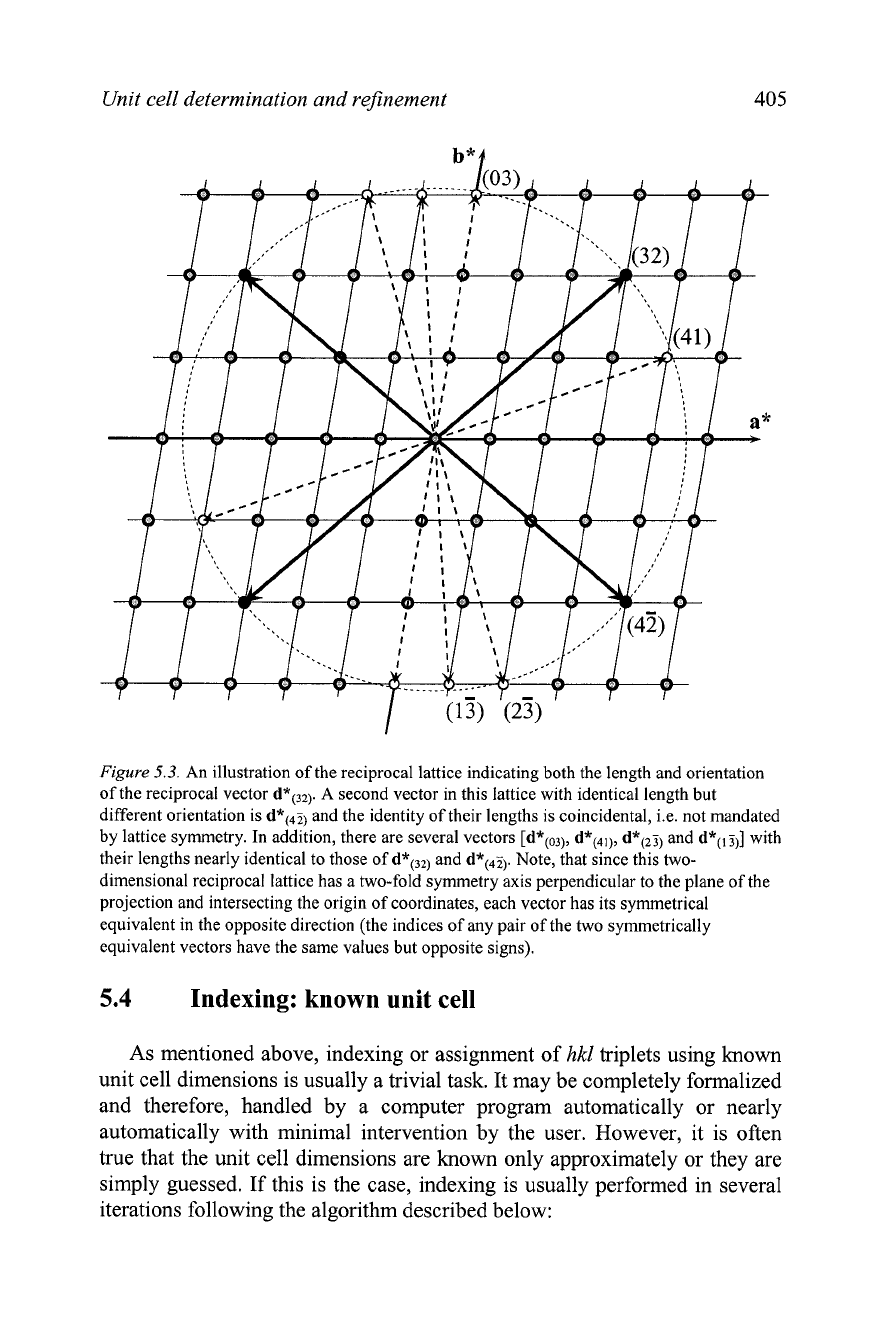
Unit cell determination and refinement
405
Figure
5.3.
An illustration of the reciprocal lattice indicating both the length and orientation
of the reciprocal vector
d*(32).
A
second vector in this lattice with identical length but
different orientation is
d*(',i)
and the identity of their lengths is coincidental, i.e. not mandated
by lattice symmetry. In addition, there are several vectors
[d*(03), d*(4,), d*(2j)
and
d*(,j,]
with
their lengths nearly identical to those of
d*(32)
and
d*(45).
Note, that since this two-
dimensional reciprocal lattice has a two-fold symmetry axis perpendicular to the plane of the
projection and intersecting the origin of coordinates, each vector has its symmetrical
equivalent in the opposite direction (the indices of any pair of the two symmetrically
equivalent vectors have the same values but opposite signs).
5.4
Indexing: known unit cell
As mentioned above, indexing or assignment of
hkl
triplets using known
unit cell dimensions is usually a trivial task. It may be completely formalized
and therefore, handled by a computer program automatically or nearly
automatically with minimal intervention by the user. However, it is often
true that the unit cell dimensions are known only approximately or they are
simply guessed. If this is the case, indexing is usually performed in several
iterations following the algorithm described below:
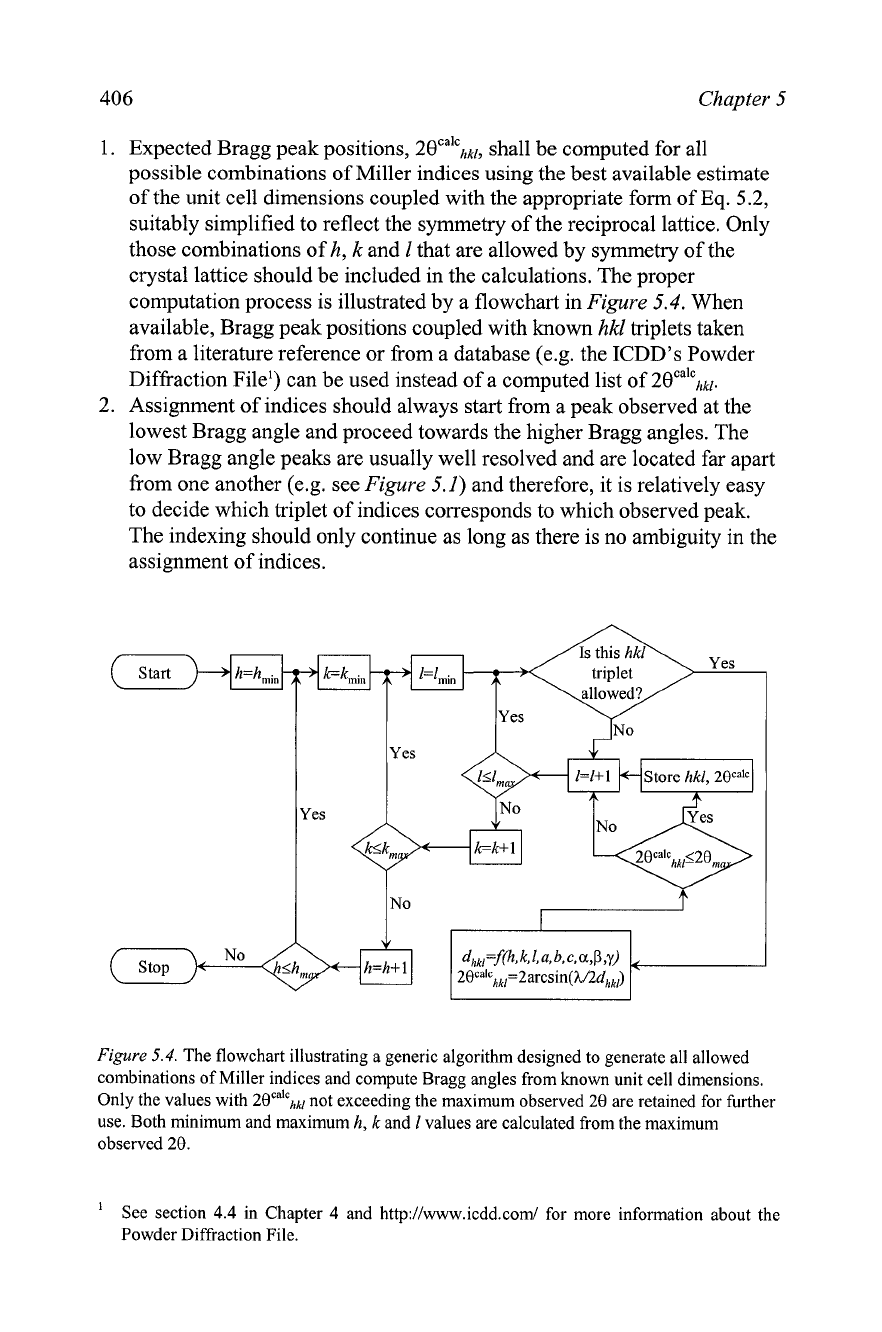
406
Chapter
5
1.
Expected Bragg peak positions, 2~~~'~hkl, shall be computed for all
possible combinations of Miller indices using the best available estimate
of the unit cell dimensions coupled with the appropriate form of
Eq.
5.2,
suitably simplified to reflect the symmetry of the reciprocal lattice. Only
those combinations of h, k and
I
that are allowed by symmetry of the
crystal lattice should be included in the calculations. The proper
computation process is illustrated by a flowchart in Figure
5.4.
When
available, Bragg peak positions coupled with known hkl triplets taken
from a literature reference or from a database
(e.g. the ICDD's Powder
Diffraction File') can be used instead of a computed list of 2eCalchk[.
2. Assignment of indices should always start from a peak observed at the
lowest Bragg angle and proceed towards the higher Bragg angles. The
low Bragg angle peaks are usually well resolved and are located far apart
from one another
(e.g. see Figure
5.1)
and therefore, it is relatively easy
to decide which triplet of indices corresponds to which observed peak.
The indexing should only continue as long as there is no ambiguity in the
assignment of indices.
Start
Yes
Figure
5.4.
The flowchart illustrating a generic algorithm designed to generate all allowed
combinations of Miller indices and compute ~ra& angles from known unit cell dimensions.
Only the values with
20Ca'chk,
not exceeding the maximum observed
20
are retained for further
use. Both minimum and maximum
h,
k
and
1
values are calculated from the maximum
observed
20.
'
See section
4.4
in Chapter
4
and http://www.icdd.com/ for more information about the
Powder Diffraction File.
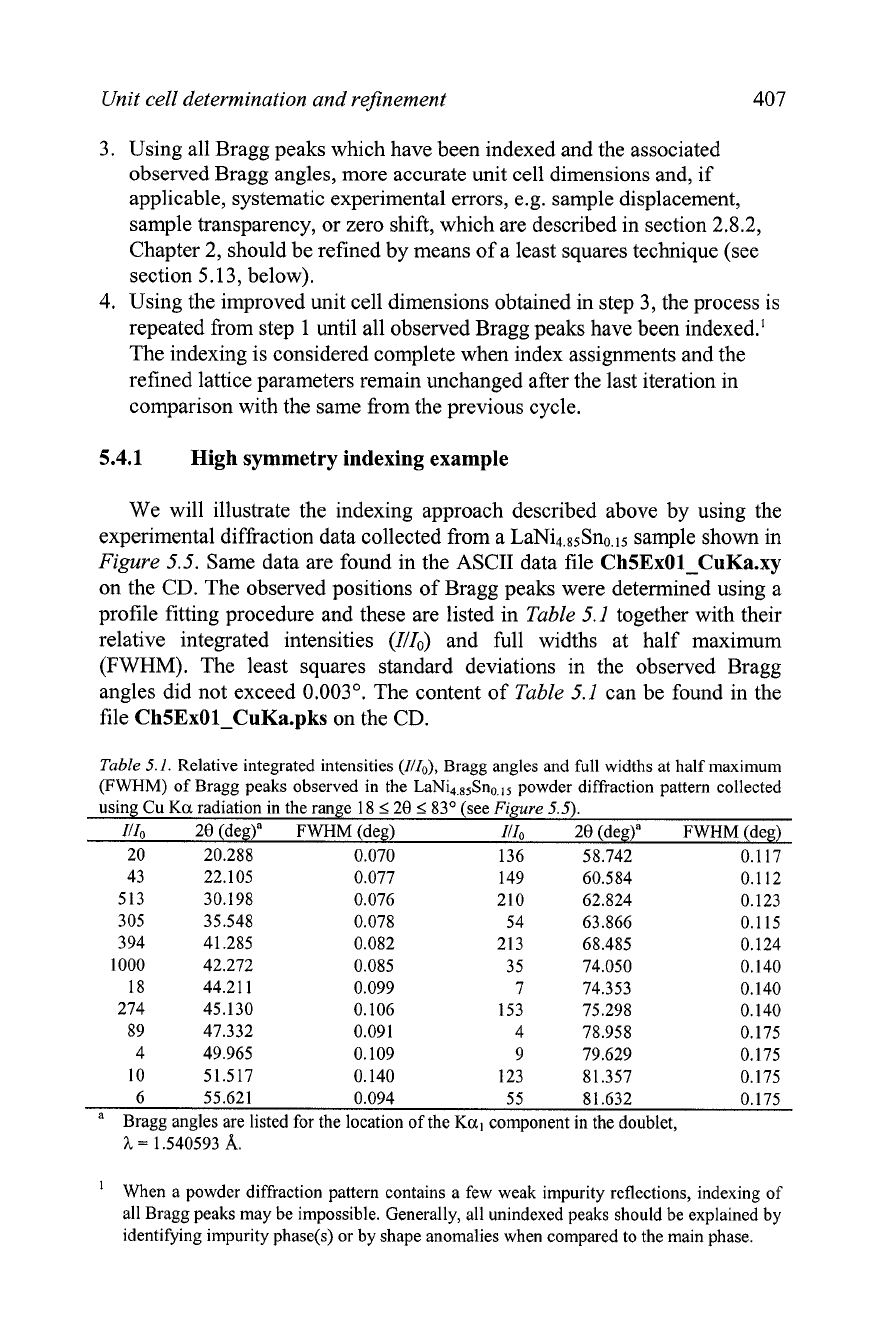
Unit cell determination and
refinement
407
Using all Bragg peaks which have been indexed and the associated
observed Bragg angles, more accurate unit cell dimensions and, if
applicable, systematic experimental errors,
e.g. sample displacement,
sample transparency, or zero shift, which are described in section 2.8.2,
Chapter 2, should be refined by means of a least squares technique (see
section 5.13, below).
Using the improved unit cell dimensions obtained in step
3,
the process is
repeated from step 1 until all observed Bragg peaks have been indexed.'
The indexing is considered complete when index assignments and the
refined lattice parameters remain unchanged after the last iteration in
comparison with the same from the previous cycle.
5.4.1 High symmetry indexing example
We will illustrate the indexing approach described above by using the
experimental diffraction data collected from a LaNi4,85Sno.15 sample shown in
Figure
5.5.
Same data are found in the ASCII data file
Ch5ExOl-CuKa.xy
on the CD. The observed positions of Bragg peaks were determined using a
profile fitting procedure and these are listed in
Table
5.1
together with their
relative integrated intensities (IIIo) and full widths at half maximum
(FWHM).
The least squares standard deviations in the observed Bragg
angles did not exceed 0.003". The content of
Table
5.1
can be found in the
file
Ch5ExOl-CuKa.pks
on the CD.
Table
5.1. Relative integrated intensities (Ill,,), Bragg angles and
full
widths at half maximum
(FWHM) of Bragg peaks observed in the LaNi485Sno,15 powder diffraction pattern collected
using Cu Ka radiation in the range
18
1
20
1
83"
(see
Figure
5.5).
Ill,
20
(deg)a
FWHM (deg) IIIo
20
(deg)a
FWHM
(deg)
20 20.288
0.070
136 58.742 0.117
43 22.105 0.077
149 60.584 0.112
513
30.198
0.076
210 62.824 0.123
305
35.548
0.078 54 63.866 0.115
3 94
41.285
0.082
213 68.485 0.124
1000
42.272
0.085
3 5 74.050 0.140
18 44.2 1 1
0.099
7 74.353 0.140
274 45.130
0.106 153 75.298 0.140
89 47.332
0.091
4 78.958 0.175
4 49.965
0.109 9 79.629 0.175
10 51.517
0.140 123 8 1.357 0.175
6 55.621
0.094 5 5 8 1.632 0.175
a
Bragg angles are listed for the location of the
Ka,
component in the doublet,
h
=
1.540593
A.
When a powder diffraction pattern contains a few weak impurity reflections, indexing of
all Bragg peaks may be impossible. Generally, all unindexed peaks should be explained by
identifying impurity
phase(s) or by shape anomalies when compared to the main phase.
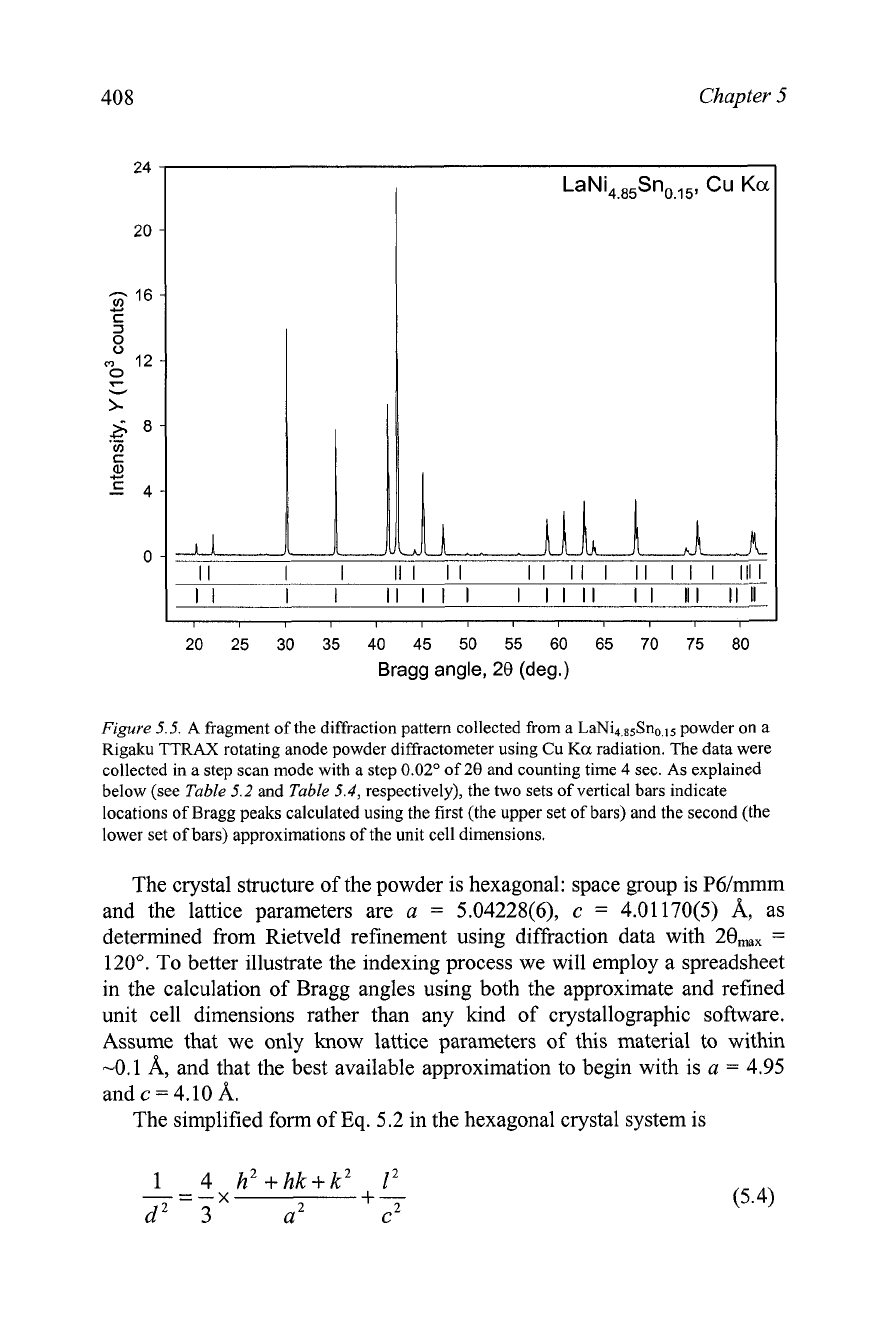
Chapter
5
LaNi
,,,,
Sn
,,,,,
Cu
Ka
20 25 30 35 40 45 50 55
60
65 70 75 80
Bragg angle,
28
(deg.)
Figure
5.5.
A fragment of the diffraction pattern collected from a LaNi4 85Sno
powder on a
Rigaku TTRAX rotating anode powder diffractometer using Cu
Ka radiation. The data were
collected in a step scan mode with a step
0.02"
of
20
and counting time
4
sec. As explained
below (see
Table
5.2
and
Table
5.4,
respectively), the two sets of vertical bars indicate
locations of Bragg peaks calculated using the first (the upper set of bars) and the second (the
lower set of bars) approximations of the unit cell dimensions.
The crystal structure of the powder is hexagonal: space group is P61mmm
and the lattice parameters are
a
=
5.04228(6),
c
=
4.01170(5) A, as
determined from Rietveld refinement using diffraction data with 20,,,
=
120'. To better illustrate the indexing process we will employ a spreadsheet
in the calculation of Bragg angles using both the approximate and refined
unit cell dimensions rather than any kind of crystallographic software.
Assume that we only know lattice parameters of this material to within
-0.1 A, and that the best available approximation to begin with is
a
=
4.95
andc=4.10
A.
The simplified form of
Eq.
5.2 in the hexagonal crystal system is
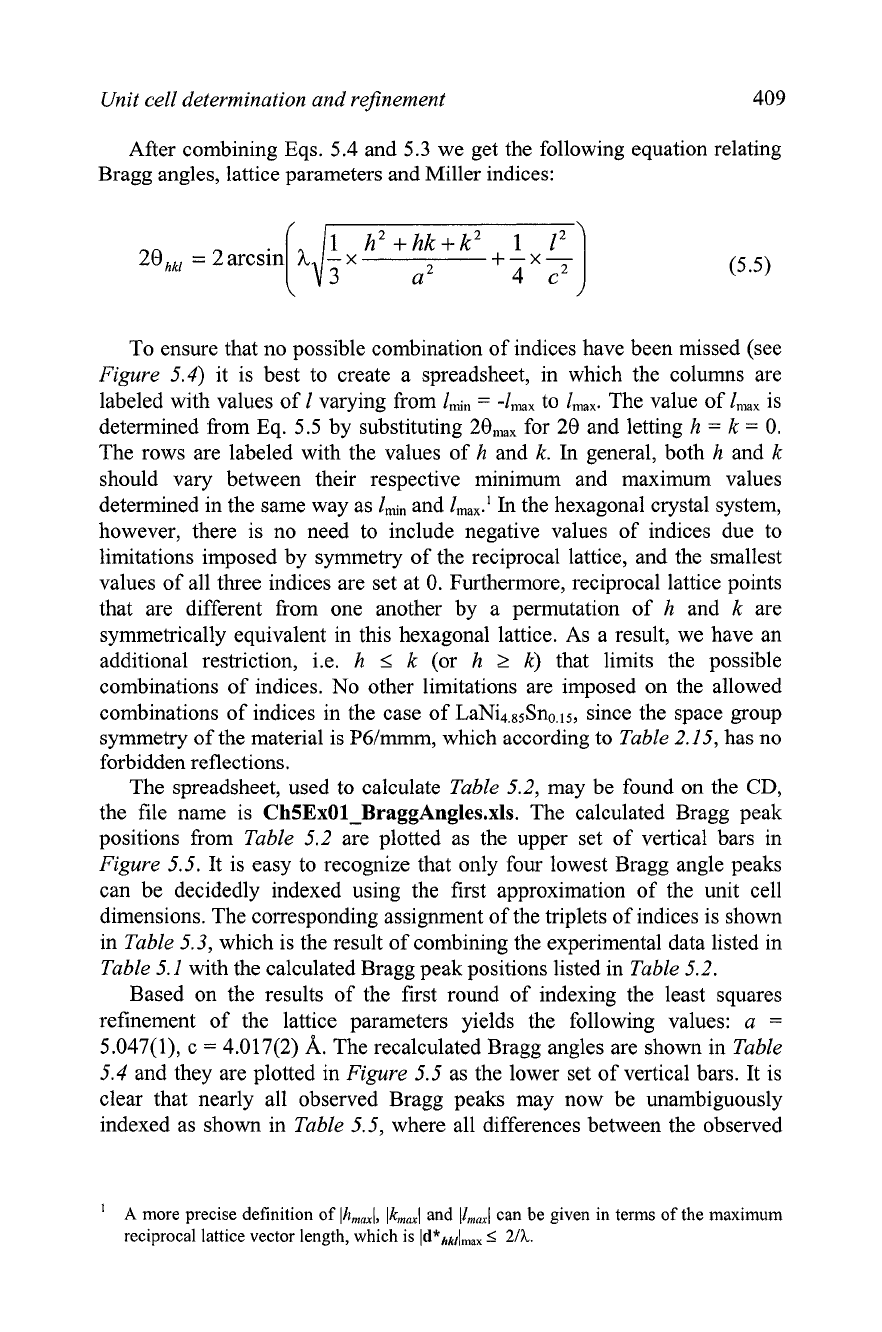
Unit cell determination and refinement
409
After combining Eqs.
5.4
and 5.3 we get the following equation relating
Bragg angles, lattice parameters and Miller indices:
To ensure that no possible combination of indices have been missed (see
Figure
5.4) it is best to create a spreadsheet, in which the columns are
labeled with values of
1
varying from
ldn
=
-1,,
to
I,,,,,.
The value of
Inlax
is
determined from Eq.
5.5
by substituting 28,,, for 28 and letting
h
=
k
=
0.
The rows are labeled with the values of
h
and k.
In
general, both
h
and k
should vary between their respective minimum and maximum values
determined in the same way as
ld,
and
I,,,,,.]
In
the hexagonal crystal system,
however, there is no need to include negative values of indices due to
limitations imposed by symmetry of the reciprocal lattice, and the smallest
values of all three indices are set at 0. Furthermore, reciprocal lattice points
that are different from one another by a permutation of
h
and k are
symmetrically equivalent in this hexagonal lattice. As a result, we have an
additional restriction, i.e.
h
I
k (or
h
2
k) that limits the possible
combinations of indices. No other limitations are imposed on the allowed
combinations of indices in the case of LaNi4.85Sno.15, since the space group
symmetry of the material is
PGImmm, which according to
Table
2.15, has no
forbidden reflections.
The spreadsheet, used to calculate
Table
5.2, may be found on the
CD,
the file name is
Ch5ExOl~BraggAngles.xls.
The calculated Bragg peak
positions from
Table
5.2 are plotted as the upper set of vertical bars in
Figure
5.5. It is easy to recognize that only four lowest Bragg angle peaks
can be decidedly indexed using the first approximation of the unit cell
dimensions. The corresponding assignment of the triplets of indices is shown
in
Table
5.3, which is the result of combining the experimental data listed in
Table
5.1 with the calculated Bragg peak positions listed in
Table
5.2.
Based on the results of the first round of indexing the least squares
refinement of the lattice parameters yields the following values:
a
=
5.047(1), c
=
4.017(2)
A.
The recalculated Bragg angles are shown in
Table
5.4 and they are plotted in
Figure
5.5 as the lower set of vertical bars. It is
clear that nearly all observed Bragg peaks may now be unambiguously
indexed as shown in
Table
5.5, where all differences between the observed
A
more precise definition of
Ih,,l, Ik,,\
and
Il,,I
can be given in terms of the maximum
reciprocal lattice vector length, which is
Id*hkllmax
5
211.
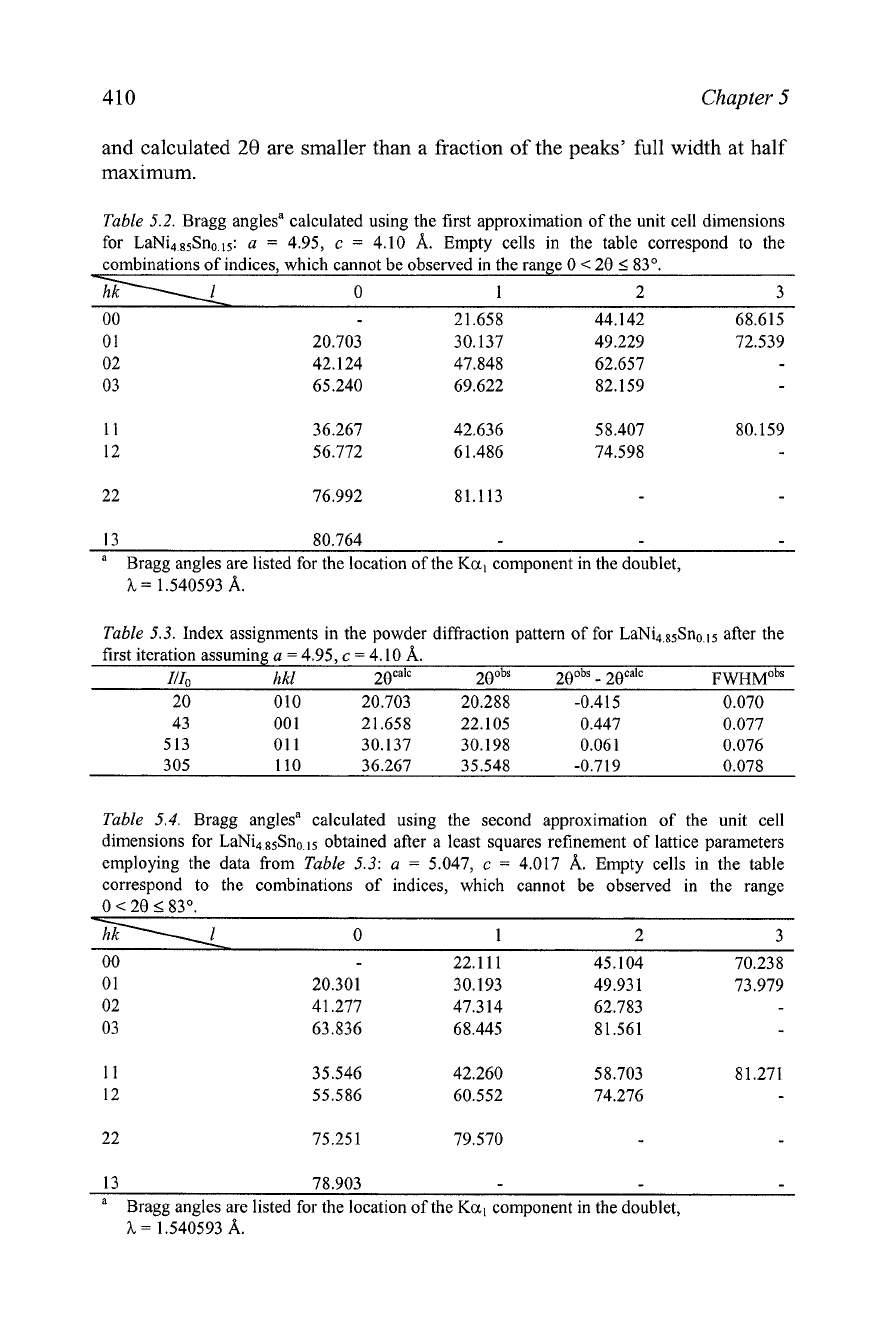
410
Chapter
5
and calculated
28
are smaller than a fraction of the peaks' full width at half
maximum.
Table
5.2. Bragg anglesa calculated using the first approximation of the unit cell dimensions
for LaNi4,85Sno.ls:
a
=
4.95,
c
=
4.10
A.
Empty cells in the table correspond to the
combinations of indices, which cannot be observed
in
the range
0
<
28
<
83".
-
-1
0
1
2
3
13
80.764
a
Bragg angles are listed for the location of the Ka, component in the doublet,
h
=
1.540593
A.
Table
5.3. Index assignments in the powder diffraction pattern of for LaNi4,85Sno.15 after the
first iteration assuming
a
=
4.95,
c
=
4.10
A.
I&
hkl
2g~al~ 280bS 2gob~
-
2g~al~
FWHMO~
20 010 20.703 20.288 -0.415 0.070
Table
5.4.
Bragg anglesa calculated using the second approximation of the unit cell
dimensions for LaNi4,8sSno.15 obtained after a least squares refinement of lattice parameters
employing the data from
Table
5.3:
a
=
5.047,
c
=
4.017
A.
Empty cells in the table
correspond to the combinations of indices, which cannot be observed in the range
0
<
28 583'.
-
~
~-
a
Bragg angles are listed for the location of the Kal component in the doublet,
h
=
1 .NO593
A.
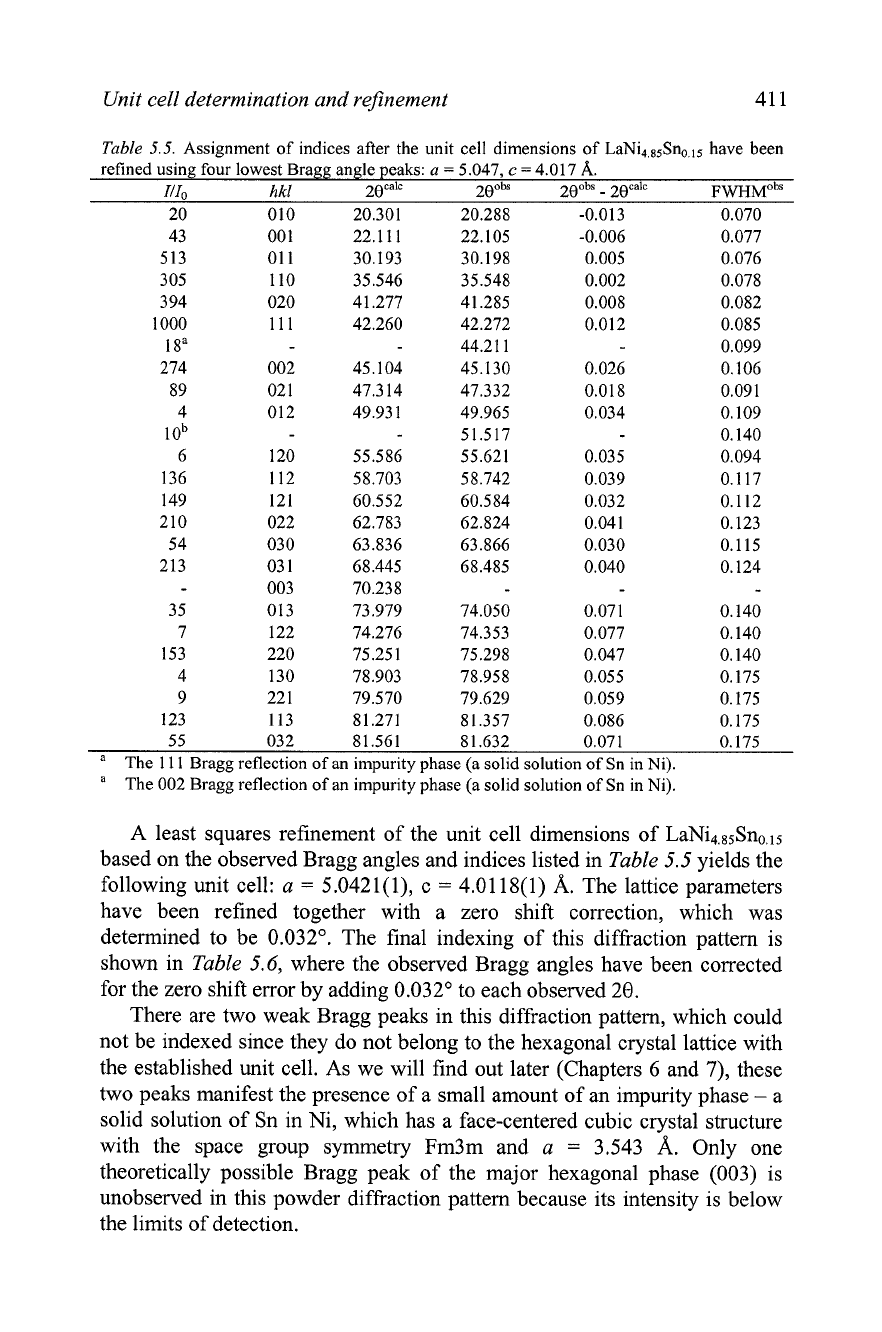
Unit cell determination and refinement
41 1
Table
5.5.
Assignment of indices after the unit cell dimensions of LaNi,,,5Sno,15 have been
refined using four lowest Bragg angle peaks:
a
=
5.047,
c
=
4.017
A.
Illo
hkl
2ecalc
200b
2e0by
2ecalc
FWHMO~~
20 010 20.301 20.288 -0.013 0.070
55
032
8
1.632 0.071 0.175
a
The
1 11
Bragg reflection of
an
impurity phase (a solid solution of Sn in Ni).
a
The
002
Bragg reflection of an impurity phase
(a
solid solution
of
Sn in Ni).
A least squares refinement of the unit cell dimensions of LaNi4,85Sno,15
based on the observed Bragg angles and indices listed in
Table
5.5 yields the
following unit cell:
a
=
5.042 1(1), c
=
4.0 1 18(l)
A.
The lattice parameters
have been refined together with a zero shift correction, which was
determined to be 0.032". The final indexing of this diffraction pattern is
shown in
Table
5.6, where the observed Bragg angles have been corrected
for the zero shift error by adding 0.032" to each observed 20.
There are two weak Bragg peaks in this diffraction pattern, which could
not be indexed since they do not belong to the hexagonal crystal lattice with
the established unit cell. As we will find out later (Chapters
6
and
7),
these
two peaks manifest the presence of a small amount of an impurity phase
-
a
solid solution of Sn in Ni, which has a face-centered cubic crystal structure
with the space group symmetry Fm3m and
a
=
3.543
A.
Only one
theoretically possible Bragg peak of the major hexagonal phase (003) is
unobserved in this powder diffraction pattern because its intensity is below
the limits of detection.
